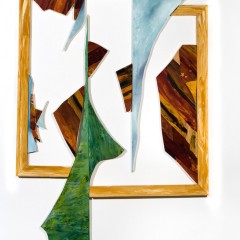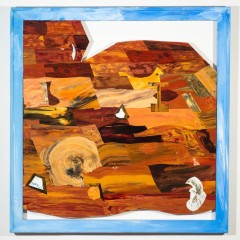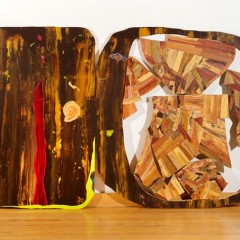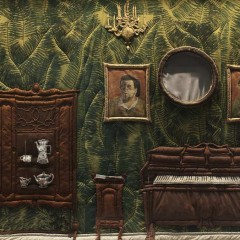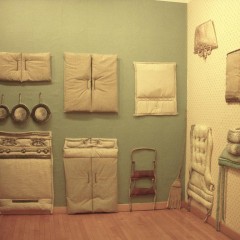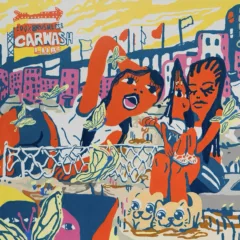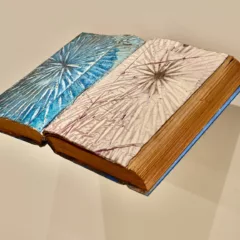Childhood games and the domestic environment set the tone in the Wind Fleisher Challenge 1. This is writ large in the work of Daniel Gerwin and Kay Healy. And, while ideas of home, family, comfort, and lack thereof and domestic activities don’t inhabit the works of Ashley Wicks, there is childhood lurking in Wicks’ animation based on paintings, which have the air of innocence about them. It’s a show that sparks memories as well as ideas about the state of contemporary art making, where ideas run the show, and work that feels impersonal is in fact deeply personal and privately-coded.
Daniel Gerwin’s portraits of life
Daniel Gerwin’s fragmented, faux-wood-grain paintings continue his twin concerns about the state of contemporary image-making and the state of the household. As a painter whose studio is in his home, and who likes it that way, Gerwin’s paintings are a perfect meld of mind and matter.
His signature, trompe l’oeil, wood-grain paintings on panel get the puzzle treatment here: He’s cut up wood panels in various sizes and shapes, and some of them seem to fit together like puzzle pieces. The artist has jiggered the fragments into uneasy relationships with standard-looking painting frames, where they mostly break the frames and create an atmosphere of comfortable discomfort. The suggestion is of a world not able to be contained within a structure, or perhaps a structure too inflexible to contain the galaxy that roils within.
In spite of their serious titles (“Midnight in the Garden of Lies;” “Injuries we hope can heal”) the works have a whimsical quality that makes me smile. We’ve all tried to shoehorn something that doesn’t fit into a box or shelf or cabinet that is stubbornly unyielding. And yet, the struggle here seems resolved with an energetic optimism. It’s the messiness of lives and people embraced and if contained, then straining to get out. The works have presence; they could be metaphorical portraits of people or situations or memories. They’re lively, and comical and beautiful to look at.
Kay Healy’s deadpan interiors
If Gerwin’s pieces exude comfort with the messiness of life or at least with life as balanced between chaos and order, Kay Healy’s stitched, relief memory room-scapes, built from stories told her by many people, are orderly, elegiac and mournful.
Healy’s stitchery is a marvel to look at. And in an Age of Ikea, whose showrooms are fantasies to dream on, Healy’s room arrangements, so life-like, so deadpan, are a jolt of reality as lived by most people everywhere (old furniture; a step stool and broom in the kitchen).
Healy lays out the stories of the objects in her tableaux in a takeaway sheet available in the gallery. I only read the stories after I had absorbed the tableaux and the stories give the works a far deeper coloration. Whereas an innocent view of the works might lead you to see them as quaint and dollhouse like (which they are). The stories of lost and found objects and people living with each other and missing each other — like the somber colors the artist has chosen for these memory rooms — brings life, death, a little humor and a lot of sadness to the table.
There’s something static in Healy’s works which seem like stage sets ready to be put to use in a drama. (I kept thinking Wes Anderson thoughts when gazing at them.) The works exude longing for the past but also a resignation with the passage of time. Healy’s open house is not a party but a wake.
Ashley Wick
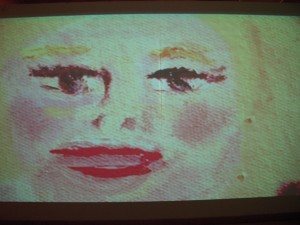
In a dark gallery, Ashley Wick’s stop-action animation streams accompanied by digital images of the paintings on which the animation is based. The video seems to focus on the sun for a very long time and then on a blonde girl’s pink-cheeked, red-lipped face, up close. The digital images of the paintings hang above eye level on cable stretched from wall to wall. Their installation is like that of Tibetan prayer flags, and that allows you to see the material from which the animation is made. Something about the child-like quality of the painting and the subject (sun, face) seems to reverberate with the other two artists’ works, and, while not focused on the domestic, Wick’s piece contains an element of memory and longing that also sits in concord with Healy and Gerwin’s works.
Another good show in the Challenge series that samples from contemporary painting, video animation and fiber art, all traditional art forms (even video animation can be called traditional in 2013), which here don’t look in any way traditional. Run out and see the show before it closes Saturday.
The Wind Fleisher Challenge 1 exhibit is up to Oct. 26. Fleisher Art Memorial, 719 Catharine Street www.fleisher.org


